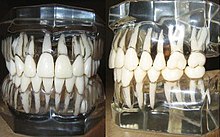Maximum intercuspation
Under the maximum Interkuspidation ( latin inter midst ', cuspis , top', 'bumps'; English maximum intercuspation ) is understood in the dentistry the complete meshing of the bumps and dimples each of the upper and lower teeth, this means a maximum multi-point contact. This stable interlocking is determined exclusively by the occlusion when the support zones are largely preserved .
In maximum intercuspation, the position of the lower jaw in relation to the upper jaw is defined in all three spatial directions. It is also called centric occlusion. The prerequisite for maximum intercuspation is a normal bite position with regular intermeshing of the posterior teeth in the transverse direction.
This position defines the anterior-posterior and lateral position of the lower and upper jaw as well as the superior-inferior positional relationship, hence the vertical jaw relation. The maximum intercuspation is an important position in determining the jaw relation in denture treatment and in orthodontics .
In the maximum intercuspation, a maximum bite force of 500 N (previously 50 kp) for the first molar region and 400 N in the premolar zone can be generated in fully and healthy teeth . In comparison, full denture wearers can generate a maximum biting force of only around 50 N in the posterior region.
Demarcation
In dentistry a distinction is made between the
- Static occlusion, which is divided into the
- Habitual occlusion (habitual position of the jaws to each other)
- Centric occlusion (tooth contact with the temporomandibular joints in a neutral position)
- Maximum occlusion and the
- Dynamic occlusion, the clenching during chewing, which is composed of the
- Anterior guidance (when advancing the lower jaw)
- Canine guidance (for sideways movements of the lower jaw)
- Group guidance (for sideways movements of the lower jaw, if the guidance is not only determined by the canines).
Individual evidence
- ↑ Joint statement by the AFDT and DGZPW: Terminology of the Working Group for Functional Diagnostics and Therapy (AFDT) and the German Society for Prosthetic Dentistry and Biomaterials (DGPro). In: Dtsch Zahnärztl Z , 61, 2006, pp. 8-10
- ↑ Klaus M. Lehmann, Elmar Hellwig, Hans-Jürgen Wenz: Dental Propaedeutics: Introduction to Dentistry; with 32 tables . Deutscher Ärzteverlag, 2012, ISBN 978-3-7691-3434-6 , p. 69 ( google.com ).
- ↑ Wolfgang Gernet, Reiner Biffar, Norbert Schwenzer, Michael Ehrenfeld: Dental prosthetics . Georg Thieme, 2011, ISBN 978-3-13-165124-2 , p. 54 ( google.com ).
- ↑ Michael Ehrenfeld, Franz Günter Sander, Norbert Schwenzer: Orthodontics . Georg Thieme, 2011, ISBN 978-3-13-165132-7 , p. 300 ( google.com ).
- ↑ Ammar Leyka, Changes in biting force after replacement or relining of total prostheses (PDF) Dissertation, 2001, p. 15. Accessed on November 13, 2015.
- ^ Nomenclature of occlusion according to the guidelines of the German Society for Dentistry, Oral and Maxillofacial Medicine , DGZMK. Retrieved November 13, 2015.

